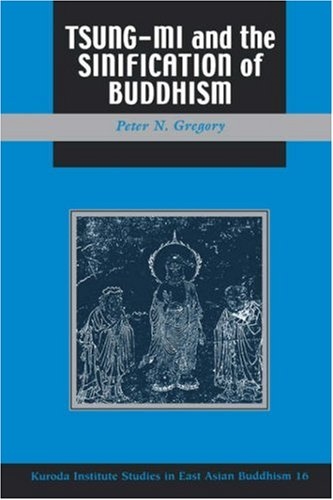No edit summary |
No edit summary |
||
| (12 intermediate revisions by 2 users not shown) | |||
| Line 3: | Line 3: | ||
|PersonPage=Gregory, P. | |PersonPage=Gregory, P. | ||
|PersonName=Peter N. Gregory | |PersonName=Peter N. Gregory | ||
}}{{Book-person | |||
|PersonPage=Zongmi | |||
|PersonName=Guifeng Zongmi | |||
}} | }} | ||
|FullTextRead=No | |FullTextRead=No | ||
|BookToc=Acknowledgments xi | |BookToc=*{{i|''Acknowledgments''|xi}} | ||
Abbreviations | *{{i|''Abbreviations''|xiii}}<br><br> | ||
*CHAPTER ONE | |||
CHAPTER | *{{i|Introduction|3}}<br><br> | ||
CHAPTER | <center>PART ONE: ''Tsung-mi's Life''</center> | ||
*CHAPTER TWO | |||
*{{i|A Biography of Tsung-mi|27}} | |||
**{{i|Classical Background (780–804)|28}} | |||
**{{i|Ch'an Training and the ''Scripture of Perfect Enlightenment'' (804–810)|33}} | |||
**{{i|Ch'eng-kuan and Hua-yen (810–816)|58}} | |||
**{{i|Early Scholarship (816–828)|68}} | |||
**{{i|Literati Connections (828–835)|73}} | |||
**{{i|The Sweet Dew Incident (835)|85}} | |||
**{{i|Later Years and Death (835–841)|88}}<br><br> | |||
CHAPTER | <center>PART TWO: ''Doctrinal Classification''</center> | ||
*CHAPTER THREE | |||
The | *{{i|Doctrinal Classification|93}} | ||
**{{i|The Hermeneutical Problem in Buddhism|93}} | |||
The | **{{i|The Chinese Context|104}} | ||
CHAPTER | *CHAPTER FOUR | ||
*{{i|Doctrinal Classification in the Hua-yen Tradition|115}} | |||
**{{i|Chih-yen's Classification Schemes|117}} | |||
**{{i|Fa-tsang's Classification Scheme|127}} | |||
**{{i|Tsung-mi's Classification Scheme|134}} | |||
*CHAPTER FIVE | |||
*{{i|The Sudden Teaching|136}} | |||
**{{i|The Sudden Teaching According to Fa-tsang|137}} | |||
The | **{{i|The Problematical Nature of the Sudden Teaching|142}} | ||
**{{i|The Sudden Teaching and Ch'an|144}} | |||
Sudden | **{{i|The Sudden Teaching in Tsung-mi's Thought|146}} | ||
Tsung-mi's | |||
CHAPTER | *CHAPTER SIX | ||
The | *{{i|The Perfect Teaching|154}} | ||
**{{i|The Samādhi of Oceanic Reflection|154}} | |||
**{{i|Two Paradigms|157}} | |||
The | **{{i|The Shift from ''Shih-shih wu-ai'' to ''Li-shih wu-ai''|162}} | ||
The | **{{i|The Teaching that Reveals the Nature|165}} | ||
**{{i|The ''Scripture of Perfect Enlightenment''|167}}<br><br> | |||
CHAPTER | <center>PART THREE: ''The Ground of Practice''</center> | ||
Tsung-mi's | *CHAPTER SEVEN | ||
*{{i|A Cosmogonic Map for Buddhist Practice|173}} | |||
**{{i|The Five Stages of Phenomenal Evolution|173}} | |||
**{{i|Nature Origination and Conditioned Origination|187}} | |||
**{{i|Sudden Enlightenment Followed by Gradual Cultivation|192}} | |||
**{{i|Tsung-mi's Ten-Stage Model|196}} | |||
PART FOUR: The Broader Intellectual Tradition | *CHAPTER EIGHT | ||
CHAPTER TEN | *{{i|The Role of Emptiness|206}} | ||
Confucianism and Taoism in Tsung-mi's Thought 255 | **{{i|A Cosmogony-Derived P'an-chiao|206}} | ||
Tsung-mi's Extension of P'an-chiao to the Two Teachings 256 | **{{i|Tsung-mi's Theory of Religious Language|209}} | ||
Tsung-mi's Critique of Confucianism and Taoism 261 | **{{i|The Meaning of Awareness|216}} | ||
The Teaching of Men and Gods 279 | **{{i|The Tathāgatagarbha Critique of Emptiness|218}} | ||
Tsung-mi's Synthesis of Confucianism and Taoism 285 | |||
Tsung-mi's Intellectual Personality 293 | *CHAPTER NINE | ||
*{{i|Tsung-mi's Critique of Ch'an|224}} | |||
**{{i|Ch'an and the Teachings|224}} | |||
**{{i|Critique of the Different Types of Ch'an|230}} | |||
**{{i|Historical Context|244}}<br><br> | |||
<center>PART FOUR: ''The Broader Intellectual Tradition''</center> | |||
*CHAPTER TEN | |||
*{{i|Confucianism and Taoism in Tsung-mi's Thought|255}} | |||
**{{i|Tsung-mi's Extension of P'an-chiao to the Two Teachings|256}} | |||
**{{i|Tsung-mi's Critique of Confucianism and Taoism|261}} | |||
**{{i|The Teaching of Men and Gods|279}} | |||
**{{i|Tsung-mi's Synthesis of Confucianism and Taoism|285}} | |||
**{{i|Tsung-mi's Intellectual Personality|293}} | |||
*CHAPTER ELEVEN | |||
*{{i|Tsung-mi and Neo-Confucianism|295}} | |||
**{{i|Chu Hsi's Critique of the Buddhist Understanding of Nature|297}} | |||
**{{i|A Common Problematic|304}} | |||
**{{i|The Problem of Predication|306}} | |||
**{{i|The Structural Parallels|309}} | |||
*APPENDIX I | |||
*{{i|A Note on Biographical Sources|313}} | |||
*APPENDIX II | |||
*{{i|A Note on Tsung-mi 's Writings|315}}<br><br> | |||
*{{i|Glossary|327}} | |||
*{{i|Bibliography|335}} | |||
*{{i|Index|355}} | |||
|AddRelatedTab=No | |AddRelatedTab=No | ||
|PublisherLogo=File:University of Hawai'i Press Logo.png | |||
|StopPersonRedirects=No | |||
}} | }} | ||
Latest revision as of 18:39, 15 September 2020
This study of Tsung-mi is part of the Studies in East Asian Buddhism series. Author Peter Gregory makes extensive use of Japanese secondary sources, which complements his work on the complex Chinese materials that form the basis of the study. (Source: University of Hawai'i Press)
| Citation | Gregory, Peter N. Tsung-mi and the Sinification of Buddhism. Kuroda Studies in East Asian Buddhism 16. Honolulu: University of Hawai'i Press, 2002. First Published 1991 by Princeton University Press. |
|---|---|


